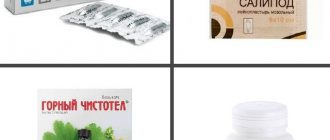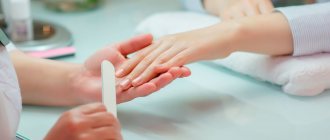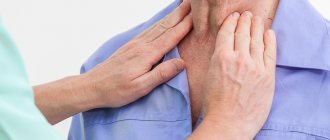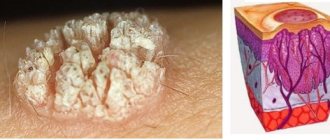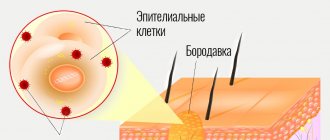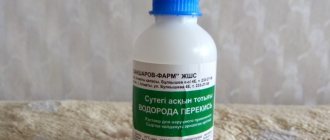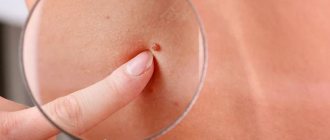Causes of warts in children
Adolescents and children going through puberty are at risk, since at this stage of life, due to changes in hormonal levels, the body becomes weak and immunity deteriorates. Since this disease is a type of benign tumor, its course and treatment should be monitored by a doctor. It is easy to become infected with papilloma viruses; they are transmitted from the carrier. They enter the body through diaper rash, minor injuries, abrasions, and may not manifest themselves for a long time. Warts in children often appear on the surface of the skin, nasal mucosa, and larynx. The latent period of development lasts from one month to six months; after reproduction, the virus affects DNA cells.
Warts in a child on the hands or other parts of the body appear as a result of:
- independent infection. If a child has a wart, he can scratch it, transferring the virus to healthy areas, including the mucous membranes of the mouth and nose;
- from mother. If the mother’s genital organs are affected by papillomas, she can infect the baby during childbirth;
- through everyday objects. This could be other people's toys, clothes, shoes, the touch of an infected baby to a healthy child, hugs.
The baby can also become infected through the placenta while inside the mother’s womb.
The main causes of warts in children include:
- hormonal imbalances (typical of teenagers);
- diseases that have become chronic;
- frequent colds, for example, flu, ARVI, acute respiratory infections;
- stress, fatigue (typical for schoolchildren);
- lack of vitamins (against this background, vitamin deficiency develops);
- injuries, diaper rash, leading to disruption of the integrity of the skin;
- communication with a carrier of the virus;
- wearing smaller clothing (including shoes).
With low activity, minor physical activity, insufficient personal hygiene, visiting bathhouses and swimming pools, you can become infected with the human papillomavirus (HPV). Infection can occur at school, transport, while walking on the street, in public places. Take into account! Parents need to teach their child from childhood to wash their hands with soap after going outside and after damaging the skin.
Types of papillomas
Depending on the location, the following types of external manifestations of HPV are distinguished:
- Vulgar (simple) warts
, which account for up to 70% of all skin warts and are more common in school-age children. They are elevations above the surface of the skin with an uneven, keratinized surface. They most often appear on the hands, but can be on the edges of the lips, on the face and, extremely rarely, on the oral mucosa. - Flat (juvenile) warts
are less common (4%). They are found in children and young people on the back of the hands and feet, face, and oral mucosa. These are warts of different shapes; they have a smooth surface and slightly rise above the skin level. - Palmoplantar warts
are very common (34% of cutaneous warts). They are dense formations with horny layers. - Filiform warts
are soft, flesh-colored to dark brown papillomas, often pedunculated. They are located on the neck, skin of the eyelids, armpits, groin, under the mammary glands. - Genital condylomas
are multiple, less often single, soft papillomas located on the mucous membranes of the genital organs, around and inside the rectum, sometimes in the urethra. They have the appearance of simple (pyramid, ball) or complex (cauliflower) growths with a keratinizing surface on the stalk.
Types of warts in children
A child’s wart on a finger, arm, or leg may be one or several. The main types of warts in children include:
- simple. They are also called ordinary or vulgar. This is the most common type. If there are several of them, then they can merge to form one root;
- flat (another name for youthful). They often merge, forming one root, usually small in size, and can line up in one line;
- spines. They arise in the area of the sole, grow deeply, which negatively affects the nerve endings;
- filiformes. Large, saggy, finger-shaped, natural skin color.
If the skin in the affected area has a gray or brown tint, this indicates the presence of a vulgar wart. Juvenile warts have a yellow or burgundy tint. The spines cause pain when walking, it is recommended not to put off visiting a doctor. Filiform warts can appear on the face and neck, which not only causes discomfort, but also looks unaesthetic. Among the presented list, there may be situations where warts are removed for children; treatment is carried out under the supervision of a doctor.
When to see a doctor
The first signs are a reason to consult a dermatologist. Remember that warts in children do not go away on their own; one formed papilloma will lead to the formation of others; they can unite to form one root. Such warts grow deep into the skin, causing discomfort, various diseases, and health problems. The virus will deplete the child’s immune system, he will become lethargic, inactive, and will often be susceptible to various diseases. JSC “Medicine” (clinic of Academician Roitberg) employs qualified doctors, uses modern equipment and the latest treatment methods. Make an appointment with a dermatologist, he will conduct an examination and select an effective treatment. The clinic is located in the center of Moscow.
Symptoms
If you suspect the appearance of a neoplasm, you should not only know what a plantar wart looks like in the photo, but also remember that the disease has characteristic symptoms:
- noticeable itching at the site of formation;
- the size of warts ranges from a few millimeters to 2 centimeters;
- unlike calluses, a wart is painful;
- bleeding when damaged;
- pain when walking.
If you experience similar symptoms, consult your doctor
. It is easier to prevent a disease than to deal with the consequences.
Removing warts in children
If the papilloma is in an open area, the child needs to remove the wart immediately. For this purpose, JSC “Medicine” (clinic of academician Roitberg) uses the following methods:
- operation;
- electrocoagulation;
- laser use;
- cryotherapy.
During surgery, warts are removed in children using a scalpel. In all other cases, special equipment is used. The choice of removal method depends on various factors: benign or malignant formation, its “age”, location, multiple or single, etc.
Operation
This method does not apply to small children. Before starting the procedure, local anesthesia is administered and removal is performed with a scalpel. Afterwards comes the postoperative period, the duration of which reaches several weeks. This is necessary to avoid infection in the wound. The surgery is performed in a clinic.
Electrocoagulation
The procedure involves the use of a special apparatus consisting of an electrode shaped like a loop. The loop is heated using an electric current, applied to the affected area, and under the influence of high temperature the papilloma is destroyed.
You can remove a wart from a child in this way under local or general anesthesia.
This is an effective treatment method; after the procedure, the area is treated with an antiseptic. A crust forms at the site of removal, which disappears after a week (maximum 10 days). A scar may remain at the site of formation.
Laser Application
An effective treatment method that is non-contact. The laser beams penetrate deep into the skin, affecting only the affected area, and there is no bleeding. This is a painless method of removal, the procedure lasts a few minutes, the wound heals without side effects or complications. The advantage of the method is the absence of marks on the surface of the skin, which is important for open areas.
Cryotherapy
The procedure involves the use of liquid nitrogen, the wart is frozen under the influence of low temperatures. The procedure does not cause bleeding; several sessions are required to completely remove the papilloma. A scar may remain; after the procedure, a blister appears at the site of formation, which over time turns into a crust and disappears. The procedure is not recommended for young children. Regardless of the method used, after the procedure you need to make every effort to strengthen the baby’s immune system. This will help avoid re-formation of papillomas.
Removal of papillomas
The question of the need to remove papillomas is decided unequivocally - it must be removed. No wonder, literally translated from some languages, a wart is “excess meat.” In addition, damage to papillomas, when they reach large sizes or are injured by linen and clothing, leads to the formation of long-healing, easily bleeding wounds into which infection can penetrate.
Removal can be done using various methods: traditional surgery, chemical cauterization, thermal or cryodestruction. The most modern and safe types of surgery are radio wave and laser.
The impact on surrounding healthy tissue is minimized. When removing warts and papillomas using these methods, the formation of scars or scars in their place is almost completely eliminated. Healing of the skin after removal occurs within several days. In parallel with the removal, antiviral therapy is necessarily carried out.
Treatment
Treatment of warts in children is carried out under the supervision of a doctor. The specialist can prescribe both removal of the papilloma and select an intensive course of treatment consisting of medications. There are cases when warts on a child’s leg are treated with a special patch, solution, or using folk remedies. Take into account! Folk remedies act as a preventive or additional method to the main drug treatment, but do not act as a separate way to get rid of warts.
Folk remedies
There are vegetables that have the same effect (freezing, relieving inflammation, cauterization) as medications and various procedures. A wart on a child’s leg or hands – what can be used:
- potato. Use it to make a compress at night;
- celandine. The juice is applied to the wart three times a day;
- celandine grass. It is mixed with medical Vaseline and applied to the site of the disease;
- garlic. Wrap in a sterile napkin and apply to the papilloma for 20 minutes;
- Apple vinegar. It is mixed with water 2:1, a swab is applied to the affected area;
- aloe. Apply the sheet to the wart, wrap the area with a bandage, change the sheet after it has completely dried;
- honey and onion, mix honey with onion juice. This method is not recommended if you are allergic to honey;
- tomato. Apply tomato pulp to the wart once a day.
Wormwood oil helps well; it can also be mixed with olive oil. Lubricate the area 4 times a day. The use of any medical product must be under the supervision of a physician. Take into account! If, after using folk remedies, the growth has dried out and fallen off, there is no guarantee that the wart has been completely eradicated; it may remain in the middle, so it will soon appear again.
How to recognize warts: symptoms and signs
An inexperienced person may confuse warts with other skin growths, for example, moles, calluses, melanomas.
The main differences between warts and moles:
- moles have a dark or black tint, while warts have a light color;
- warts grow tightly together with the skin, moles are separate structures, as if glued to the body;
- moles are soft and smooth to the touch, warts are hard, hard and rough.
It is also easy to distinguish a wart from a callus. When pressing on the growth, painful sensations will occur, and if it peels off, traces of hemorrhages will be visible underneath it. Under the callus is new, tender skin.
You can distinguish a wart from a melanoma by color and shape. This dangerous disease is characterized by heterogeneous red and black shades, proliferation and an uneven contour.
It is not difficult for a dermatologist to make the correct diagnosis using a visual examination. But a good specialist will not be content with just a simple inspection. He will definitely use a special magnifying device - a dermatoscope. If there is a suspicion of a pathogenic process, scraping of the surface layer will be required.
In the case of anogenital warts (located around the anus and on the genitals), consultation with a gynecologist or proctologist is necessary.
Wart on the back, face, nose - how to treat
These are special areas where the skin is delicate and sensitive. It is necessary to remove papillomas here with extreme caution so that there are no scars left (especially when it comes to the face area). The first stage of treatment is medication; a dermatologist may prescribe a gentle ointment, which should be used at night. The child may also be prescribed medications that stimulate the immune system. To remove papillomas on the face or back, specialists from Meditsina JSC (academician Roitberg’s clinic) recommend using laser therapy. This will allow you to avoid scarring after the procedure.
Flat (juvenile) warts
Flat warts are a fairly common type of tumor and the least problematic. They present as small lenticular lesions (several mm in diameter) or smooth papular lesions. They can grow either singly, which is quite rare, or in large numbers, close to each other.
There are several stages of the disease:
- mild – one or several painless warts;
- medium – from 10 to 100 painless growths;
- severe – more than 100 neoplasms.
If they are localized in places that experience excess pressure (friction from clothing, shoes, etc.), they cause pain.
Flat warts are easily identified and have a white, brown, yellowish or pink hue, similar to the color of meat. They are about the size of a pinhead and, compared to other types of warts, are smoother and flatter. In fact, at the point where a flat wart develops, the skin rises slightly (to a height of about 5mm), forming a sort of raised circular area.
The growths typically appear on the face, knees, elbows, back, legs, and arms (especially the fingers). People of absolutely any age become victims of this disease. But most often it affects children and adolescents (20% of schoolchildren have it), hence the second name for warts - juvenile.
In a close group of schoolchildren, 80% show resistance (resistance) to the virus. In adults, irritation and inflammation after shaving contribute to the proliferation of tumors.
The incubation period of infection can last up to 8 months. Mostly the disease is only a cosmetic defect. Juvenile warts are painless unless caused by mechanical pressure or injury and can sometimes cause itching, but are extremely contagious.
The virus is practically not transmitted through shared objects; the main route of infection is skin contact. Flat warts multiply so easily that it is enough to touch a healthy part of the body to cause the birth of a new formation.
The peculiarity of this type of wart is that in most cases no treatment is required: they can disappear as suddenly as they appeared, especially in children. In adults, the disease must be treated, and the virus is very resistant to drug treatment.
Tips for parents
To avoid the formation of warts in children, teach your child hygiene, the use of personal soap and towels from childhood. Parents should monitor how correctly and carefully the child follows their recommendations. Hand washing is the first thing a child should do after walking outside and before eating. It is necessary to provide your child with healthy nutrition. It should consist of products containing calcium, fluorine, and iron. Include fermented milk products, fish, cereals, vegetables, and fruits in your diet. Cereals such as pearl barley and oatmeal. Food should contain a full range of vitamins and microelements.
Walking in the fresh air and playing sports are integral elements of a child’s life. This is what will help strengthen the baby’s immunity. If a child is injured, for example, falls and a wound forms, treat it with an antiseptic. Minimum stress – maximum benefit for the baby. If a wart appears, make an appointment with a pediatric dermatologist. Do not self-medicate, this may make the situation worse.
Where do plantar warts come from?
HPV enters the body from the outside. Pathogens love moist environments. You can become infected by wearing someone else's shoes, neglecting the rules of hygiene in pedicure salons, baths, saunas or swimming pools. A virus suppressed by the immune system may not manifest itself for years. But in a weakened body, viral particles begin to divide very quickly. The propagation of plantar strains is facilitated by:
- increased sweating of the feet;
- uncomfortable tight shoes;
- microcracks in the skin;
- fungal infections of the feet;
- circulatory disorders due to joint deformation: arthritis, arthrosis, flat feet.
Within the epidermis, the virus first infects the basal layer. Then it provokes the proliferation of keratinized particles, forming characteristic hard plaques on the skin.
The main symptom of this form of HPV is severe pain while walking. The roots reaching the lower layer of the dermis constantly injure the nerve endings. Many patients have to give up their usual shoes and use thick, soft insoles to alleviate the pain.
How to make an appointment with a dermatologist
You can make an appointment with a pediatric dermatologist at Meditsina JSC (academician Roitberg’s clinic) by phone. Also use the feedback form by sending a request using the website, or order a call. We employ qualified doctors with many years of practice. Remember that self-medication can lead to serious consequences. Experts say that most ointments for the treatment of warts actually only mask the symptoms, but do not get rid of the disease itself, so only a specialist should prescribe medications and choose a method of removal after conducting the necessary examinations.
The clinic is located in the center of Moscow, treatment is carried out using modern techniques, devices, and equipment. The doctor will advise you on any issue, carefully study the symptoms, the source of the disease, conduct diagnostics, prescribe tests, and select an effective way to remove warts in children.
Are warts always dangerous?
Most warts are completely harmless and can theoretically disappear in a few weeks or at most a month. In this case, patients are more likely to be concerned about a serious cosmetic defect, which causes psychological discomfort and interferes with leading a full lifestyle.
Warts are often painless unless they are on the soles of the feet or another part of the body that is subject to shock or constant contact. But there are cases of itching and discomfort in the affected area.
But as mentioned above, warts are viral in nature, so you cannot expect that the neoplasm will go away on its own or will not bother you for the rest of your life. Any wart should be shown to a dermatologist, and if he deems it necessary, it should be removed using one of the safe methods.
Medicines for plantar warts
The composition of drugs for removing papillomas includes antiviral compounds, immunomodulators or substances that loosen the stratum corneum of the skin. Pathogens that suppress the reproduction include:
- Fluorouracil: 5% cream for topical use, activates protective cells, slows the growth of warts;
- Imiquimod: promotes the production of interferons, prevents further damage to the skin;
- Viferon: gel for external application, has high antiviral activity.
These drugs have virtually no side effects, but at an advanced stage of papillomatosis they are ineffective. To destroy and remove large warts, keratolytics, necrotizing agents, and cryogenic agents are used. All of them require careful handling, as they contain acids, alkalis and other chemically active components. Dermatologist approval is required before use.
Popular remedies for warts:
- Salipod: a patch with salicylic acid, softens the affected layers of the skin, allowing you to remove the wart and get to its root;
- Super celandine: a solution that “burns out” the keratinized layers, promotes necrotization and death of papillomas;
- Cryopharma: a solution in aerosol form, contains a nitrogenous compound that freezes areas of affected tissue.
These medications must be applied pointwise to warts, strictly following the instructions so as not to damage healthy skin. The period of death of warts after their use: from 5 to 20 days. In advanced cases, you need to repeat the procedure. Remains of papillomas must be removed mechanically, and wounds must be treated with iodine solution.
